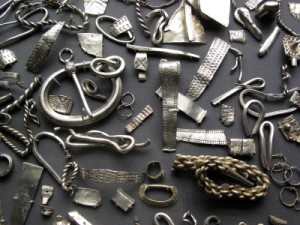 Almost every piece of jewelry you’ll find is a combination, or alloy, of several different metals
Almost every piece of jewelry you’ll find is a combination, or alloy, of several different metals
Most jewelry allergies are invariably your body’s reaction to one of these other metals in the jewelry, and not to gold or silver. Usually, you’ll break out with redness and some swelling right where you wear your ring, or where your necklace rides. Like other allergies, allergies to metals can come and go and are more likely to recur once you’ve had an initial reaction.
A lot of jewelry nowadays is made with nickel, which is common inexpensive alloy used mostly because of its anti-corrosive qualities. Unfortunately, allergy to nickel is one of the most common skin allergies, preventing many people from wearing conventional, imported budget jewelry.
Click here to learn more about dealing with a nickel allergy
There are options, of course. Sterling silver is generally tolerated by people with nickel allergies, as well as is gold. Though sterling silver isn’t 100% pure silver, it’s close, containing 92.5% silver and 7.5% other metals, such as copper. Likewise, pure gold is 24 karat and is much too soft to make jewelry that will hold up to everyday use, so again, it is alloyed with other metals such as silver, copper and zinc.
Click here to learn more about buying gold jewelry
When you buy from BlackHillsGoldSource.com you don’t need to worry about metal allergies. Landstroms Black Hills Gold and silver jewelry is made in America from genuine Black Hills Gold and .925 sterling silver by Landstroms – a name you can trust.
If you have a piece of heirloom jewelry and it’s just breaking your heart because you cannot wear it due to a jewelry allergy, you can also consider having it plated with Rhodium or Palladium. Usually, your quality local jeweler can help you with this.
***If you’ve enjoyed this article, please link back to us at: